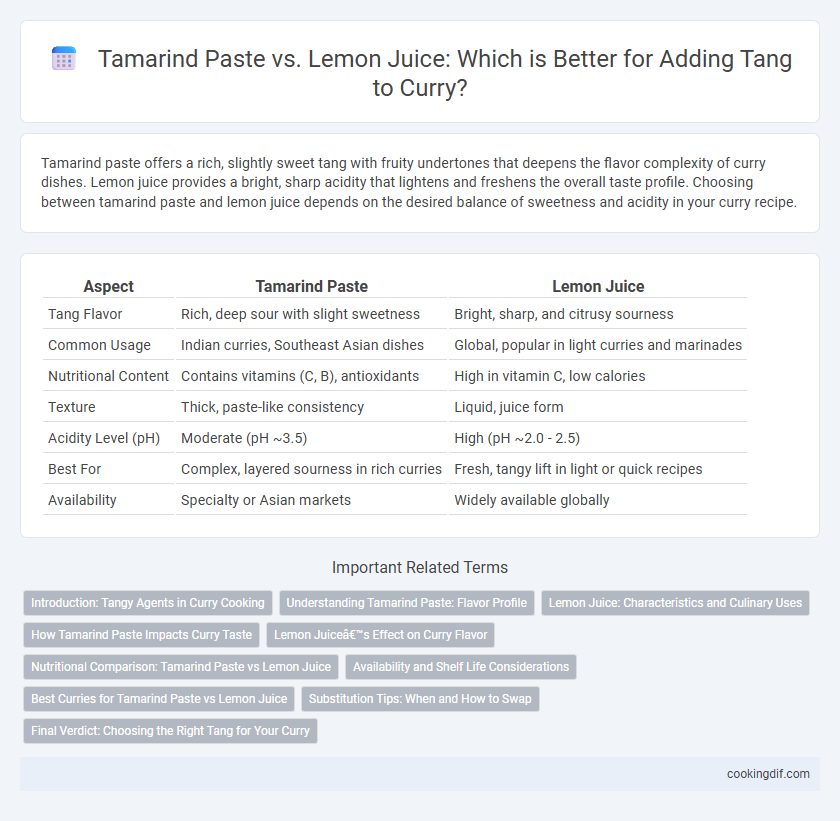Tamarind paste offers a rich, slightly sweet tang with fruity undertones that deepens the flavor complexity of curry dishes. Lemon juice provides a bright, sharp acidity that lightens and freshens the overall taste profile. Choosing between tamarind paste and lemon juice depends on the desired balance of sweetness and acidity in your curry recipe.
Table of Comparison
| Aspect | Tamarind Paste | Lemon Juice |
|---|---|---|
| Tang Flavor | Rich, deep sour with slight sweetness | Bright, sharp, and citrusy sourness |
| Common Usage | Indian curries, Southeast Asian dishes | Global, popular in light curries and marinades |
| Nutritional Content | Contains vitamins (C, B), antioxidants | High in vitamin C, low calories |
| Texture | Thick, paste-like consistency | Liquid, juice form |
| Acidity Level (pH) | Moderate (pH ~3.5) | High (pH ~2.0 - 2.5) |
| Best For | Complex, layered sourness in rich curries | Fresh, tangy lift in light or quick recipes |
| Availability | Specialty or Asian markets | Widely available globally |
Introduction: Tangy Agents in Curry Cooking
Tamarind paste and lemon juice are essential tangy agents that define the distinct sourness in curry dishes. Tamarind paste provides a deep, slightly sweet and fruity tartness derived from the tamarind fruit, widely used in South Indian and Southeast Asian curries. Lemon juice offers a bright, sharp acidity that enhances freshness and balances spices, commonly favored in North Indian and Caribbean curry recipes.
Understanding Tamarind Paste: Flavor Profile
Tamarind paste delivers a complex tangy flavor with subtle sweetness and fruity undertones, making it a unique addition to curry dishes compared to the sharper acidity of lemon juice. Its rich, slightly sour taste enhances the depth of spices and balances savory elements without overpowering the dish. Unlike lemon juice, tamarind paste adds a smooth, mellow tang that complements slow-cooked curries and layered spice blends in Indian and Southeast Asian cuisine.
Lemon Juice: Characteristics and Culinary Uses
Lemon juice offers a vibrant citrusy tang with refreshing acidity that brightens curry dishes without overpowering other flavors. Its natural citric acid enhances the complexity of spices and balances rich, creamy textures typically found in Indian and Southeast Asian curries. Commonly used as a finishing touch, lemon juice preserves the freshness of herbs and provides a zesty complement to tamarind paste's deeper, earthier sourness.
How Tamarind Paste Impacts Curry Taste
Tamarind paste delivers a deep, rich sourness that enhances curry by adding a complex, slightly sweet tang, balancing spicy and savory flavors more effectively than lemon juice. Its unique acidity intensifies the umami profile, creating a thicker texture and a robust, earthy undertone essential to traditional Indian and Southeast Asian curries. Unlike the sharper, brighter taste of lemon juice, tamarind paste provides a mellowed sourness that melds seamlessly with spices like cumin, coriander, and turmeric, elevating the overall depth of the dish.
Lemon Juice’s Effect on Curry Flavor
Lemon juice enhances curry flavor by adding a bright, zesty acidity that balances rich and spicy elements, creating a more vibrant and fresh taste profile. Its natural citrus compounds elevate the overall aroma and cut through heavy spices, allowing other ingredients to shine. Unlike tamarind paste, which provides a deep, sweet-sour tang with a slightly fruity complexity, lemon juice delivers a sharper, cleaner sourness that intensifies without overpowering.
Nutritional Comparison: Tamarind Paste vs Lemon Juice
Tamarind paste offers a rich source of antioxidants, vitamins B and C, and minerals like potassium and magnesium, contributing to overall nutritional value in curry dishes. Lemon juice provides a high concentration of vitamin C, crucial for immune support and enhancing iron absorption from food. Both ingredients contribute tanginess, but tamarind paste adds more complex nutrients, while lemon juice delivers a sharper vitamin C boost.
Availability and Shelf Life Considerations
Tamarind paste offers a concentrated tang often used in South Asian curries, with a shelf life of up to two years when refrigerated, making it a convenient, long-lasting option. Lemon juice provides a fresh, bright acidity but tends to spoil quickly, usually within a week when refrigerated, and is less suitable for long-term storage. Availability varies regionally; tamarind paste is more common in specialty and ethnic markets, while lemon juice is widely accessible in grocery stores worldwide.
Best Curries for Tamarind Paste vs Lemon Juice
Tamarind paste delivers a rich, slightly sweet and sour tang ideal for South Indian and Thai curries like sambar and Massaman curry, where its depth enhances complex spice blends. Lemon juice offers a bright, sharp acidity suited to lighter curries such as Goan fish curry and North Indian kadhi, providing a fresh citrus note that balances creamy or yogurt-based sauces. For authentic flavor profiles, tamarind paste best complements earthy, tamarind-centric recipes, while lemon juice excels in dishes requiring clean, vibrant acidity.
Substitution Tips: When and How to Swap
Tamarind paste delivers a deep, fruity tang with subtle sweetness, making it ideal for rich, slow-cooked curries, while lemon juice offers a bright, sharp acidity better suited for fresh, quick dishes. Substitute lemon juice for tamarind paste using a quarter of the amount to avoid overpowering the dish, adjusting sourness gradually to maintain balance. For best results, dissolve tamarind paste in warm water before adding, and add lemon juice at the end of cooking to preserve its vibrant flavor.
Final Verdict: Choosing the Right Tang for Your Curry
Tamarind paste offers a deep, complex tanginess with subtle sweetness and fruity undertones, enhancing traditional Indian and Southeast Asian curries. Lemon juice provides a sharp, bright acidity that cuts through rich, creamy dishes, adding freshness without overwhelming other flavors. For authentic depth and balanced sourness, tamarind is preferred, while lemon juice suits quick, vibrant curries needing immediate brightening.
Tamarind Paste vs Lemon Juice for tang Infographic

 cookingdif.com
cookingdif.com